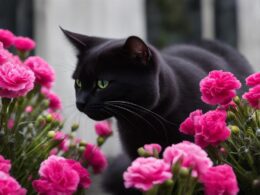Welcome to our informative guide on the safety of baby’s breath for cats. As a cat owner, you want to ensure that your furry friend is protected from any potential hazards. In this article, we will explore whether baby’s breath poses any toxicity risks to cats and provide you with essential safety guidelines.
Baby’s breath, also known as Gypsophila, is a beautiful flowering plant commonly found in flower arrangements and gardens. Many cat owners may wonder if this delicate flower can be harmful to their feline companions. While baby’s breath is generally considered safe for cats, it’s important to be aware of certain factors that can affect their well-being.
Cats are curious creatures, and their exploratory nature may lead them to nibble on plants or flowers. When it comes to baby’s breath, consuming high amounts can cause mild symptoms such as stomach upset.
Smaller cats, in particular, are more susceptible to these problems. It’s essential to monitor cats with underlying health conditions or cats who are young, old, or weak, as they may be more vulnerable to the effects of baby’s breath.
The flower itself is classified as “mildly toxic,” but severe complications are rare. Symptoms of baby’s breath ingestion in cats may include vomiting, diarrhea, lethargy, loss of appetite, and potential dehydration.
In most cases, a trip to the vet is not necessary if your cat has ingested a minimal amount of baby’s breath and only experiences mild symptoms. However, it is always recommended to contact your vet if severe symptoms persist or if you have any concerns about your cat’s well-being.
Now that you have a better understanding of the potential risks associated with baby’s breath and cats, you can take appropriate measures to ensure your feline friend stays safe and healthy.
Baby’s Breath and Cats: Is it Safe to Have at Home?
Baby’s breath, also known as Gypsophila, is a flowering plant commonly used in flower arrangements. It adds a delicate touch and beautiful aesthetic to bouquets and gardens. However, if you have cats at home, it’s important to consider their safety when it comes to having baby’s breath around.
While baby’s breath is generally safe for cats, it is classified as mildly toxic. This is due to the presence of gyposenin, a saponin found in the plant. Gyposenin can irritate the gastrointestinal tract of cats if ingested, leading to potential health issues.
If your cat were to consume baby’s breath, they may experience symptoms such as:
- Vomiting
- Diarrhea
- Lack of appetite
- Lethargy
- Depression
While these symptoms are generally not life-threatening, they can cause discomfort and distress for your feline companion. It’s best to prevent your cat from coming into contact with baby’s breath to avoid any potential health issues.
If you have baby’s breath in bouquets or gardens, it’s advised to remove it or keep it in a location that is inaccessible to cats. By taking this precaution, you can ensure the safety and well-being of your furry friend.
Can Baby’s Breath Pose a Risk to Cats if They Roam Around Flower Beds?
Yes, baby’s breath can pose a risk to cats if they roam around flower beds. It’s important for pet owners to take safe tips for flower beds into consideration and ensure that any potentially toxic plants, including baby’s breath, are not accessible to cats.
Conclusion: Baby’s Breath and Cat Safety
In conclusion, it is important to be aware that baby’s breath is classified as mildly toxic to cats. While the ingestion of this flower may cause gastrointestinal upset, the symptoms are usually minor and self-limiting. Most cats will recover within 24 hours.
Although severe complications are rare, caution should be exercised with cats that have underlying health conditions or those who are young, old, or weak, as they may be more susceptible. If you suspect that your cat has ingested baby’s breath and experiences severe symptoms or signs of dehydration, it is recommended that you contact your vet for further guidance.
To ensure the safety of your feline companion, it is best to keep baby’s breath away from cats and monitor their behavior if they are exposed to this flower. By taking these precautions, you can help protect your cat’s well-being and create a safe environment in your home.









